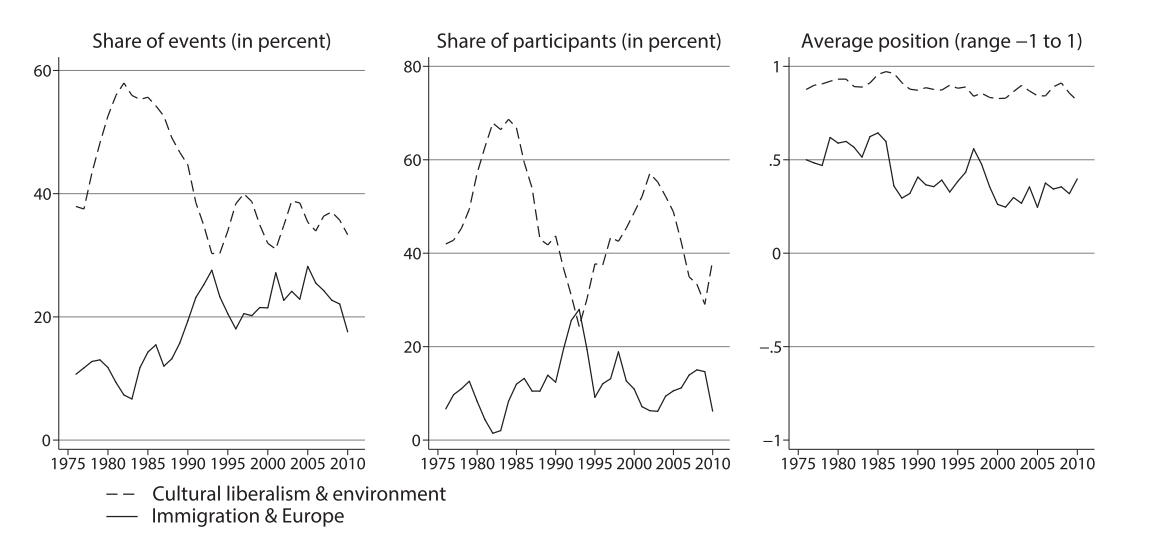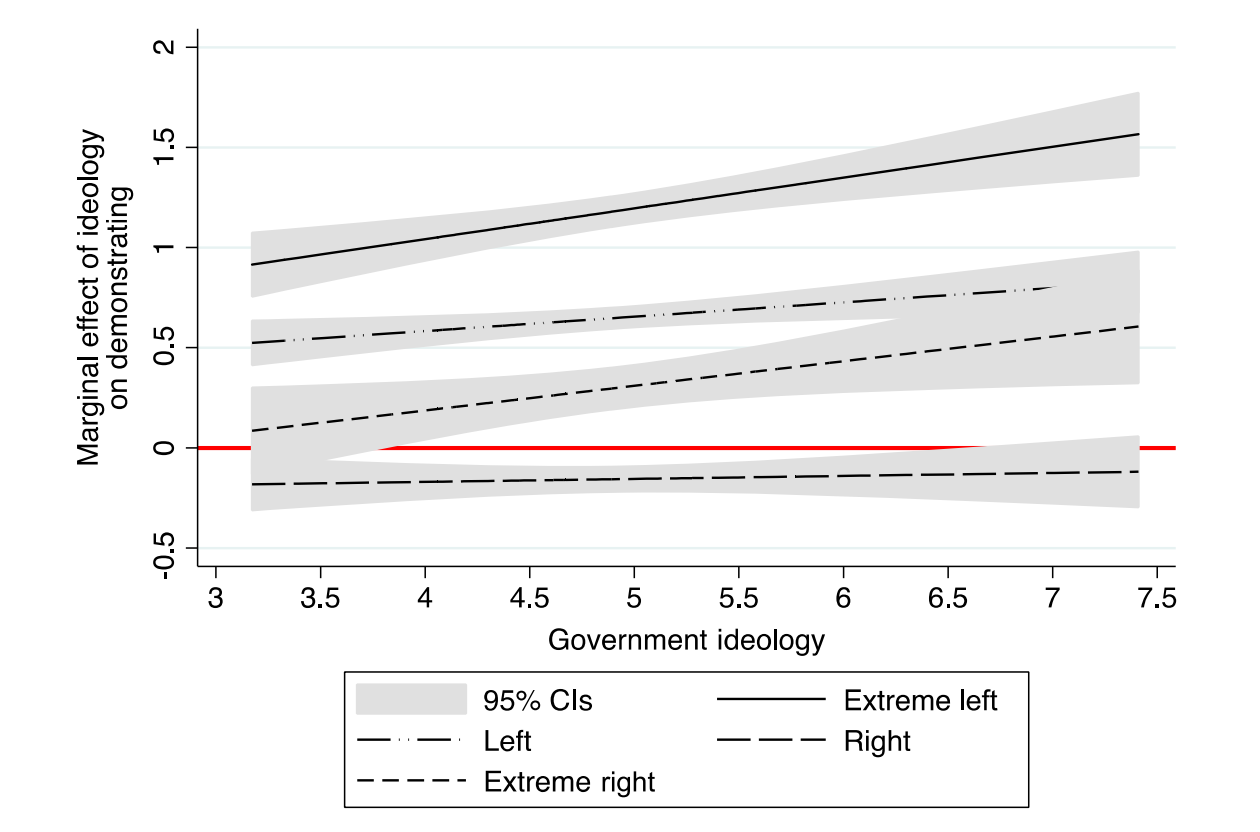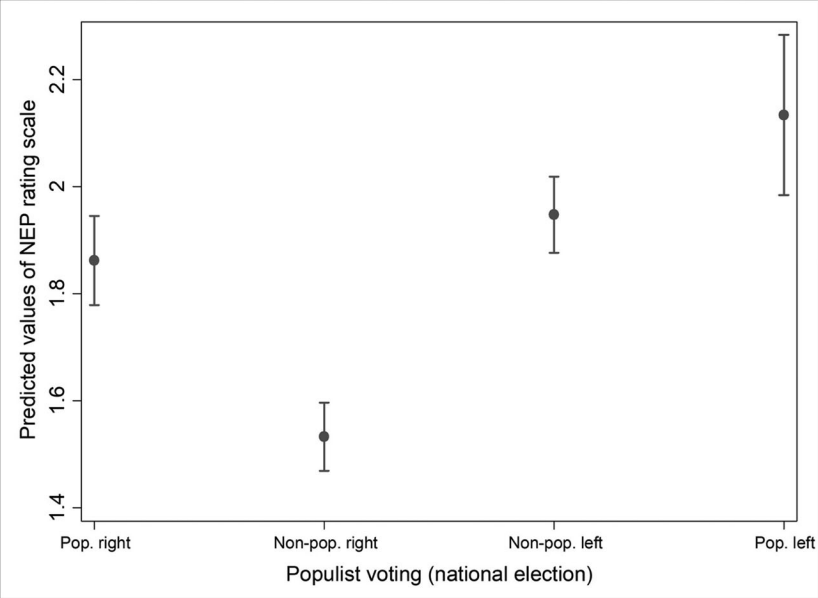Why don't we see Never Trumpers in the streets?
The attempted insurrection on January 6th has got me thinking back to an old debate in political science about which political groups take to the streets, and which ones don’t.
In the U.S., of course, the past few years have been dominated by broad-based progressive movements, from the Women’s march, to protests against the Trump administration’s immigration policies, to Black Lives Matter.
Even some of the most high profile right-wing protest events, like the “Unite the Right” rally in Charlottesville, were relatively small scale, with participants numbering in the hundreds rather than thousands. (Which, of course, does not mean these events should not be taken very seriously indeed.)
A second “Unite the Right” rally in D.C. a year later attracted only about 20 white nationalist protesters, who were vastly outnumbered by counter-protesters.
And so watching the footage from the Capitol last week was a jarring reminder that the right is capable of organizing mass protest movements.
What makes this surprising, from a theoretical perspective, is that political scientists have long observed that mass protest movements tend to be dominated by the libertarian-left.
(Just to clear up any confusion, “libertarian” in this context means the opposite of authoritarian, and not, like, Rand Paul or whoever.)
Even if you’re not a political scientist, you’ve probably seen the “political compass” meme in some format:
In short, the horizontal axis indicates position on economic issues (more or less state intervention in the economy) and the vertical axis indicates position on cultural issues (tradition vs openness; nationalism vs cosmopolitanism).
Empirically, the bottom-left quadrant, the left-libertarians, still dominate the sphere of protest politics — despite the rise of the populist and radical right across Europe in recent decades.
For example, Hutter and Borbáth (2019) created a huge dataset of nearly 20,000 protest events in 6 European countries from 1975-2011, based on newspaper reports. They coded the protest events based on the issue (environment; cultural liberalism; immigration; European integration) and the position being expressed.
The first two panels of this figure show that immigration and the EU have become increasingly salient in protest politics, both in terms of the number of events and the number of participants.
However, the left-libertarian dominance remains, because the third panel shows that on average, even the immigration protests are still mostly pro immigration!

Figure 2 from Hutter and Borbáth (2019)
(Here, the “pro” positions are coded as +1 while the “anti” positions are coded as -1. So when the average is positive, that means the protests on that issue lean towards the “pro” side.)
We can certainly see a downward trend, indicating that immigration/integration protests have shifted towards the “anti” position over time. And clearly protests on these issues are much more evenly split that protests on the environment and cultural liberalism (e.g., LGBT rights), which are overwhelmingly dominated by the “pro” position.
Still, it’s a remarkable result given the dramatic successes of anti-immigration parties at the polls.
So… why do the left-libertarians tend to dominate the sphere of “protest politics”, even when they are struggling in the electoral sphere?
Sore losers?
Perhaps this isn’t so much of a contradiction after all. Maybe left-wingers are more inclined to take to the streets precisely because they aren’t having so much success at the ballot box?
It’s an appealing logic. And certainly, in the U.S. context, the election of Donald Trump seems to have played a large role in spurring a renewal of mass protest on the left.
But, more broadly, the protest sphere has been dominated by left-wingers long before the electoral decline of mainstream left parties.
In fact, a recent study Torcal, Rodon, and Hierro (2016) showed that while left-wingers are more likely to protest under a right-wing (vs left-wing) government, they are still the most likely group to be protesting under a left-wing government!

Figure 3 from Torcal, Rodon, and Hierro (2016)
Demographics
Another explanation that we can quickly dispense with is the claim that left-libertarians tend to protest more simply because they have the luxury of being highly-educated and mostly well-off.
Many studies have documented that those with libertarian values are more inclined to take part in protests than those with authoritarian values, even controlling for a range of individual demographics, such as age, gender, and educational attainment.
(That is: even if we just compare individuals of the same age, gender, and education, those who are more libertarian still tend to protest more.)
Protest values and valuing protest
Perhaps libertarians dominate the protest sphere simply because libertarian values are more conducive to protest politics than authoritarian values?
Libertarians are more comfortable than authoritarians with types of political action that challenge the status quo.
Indeed, many political scientists argued that these value orientations can help us to understand why the populist right – which pits “the people” against a corrupt political system – tends to use highly-institutionalized channels (elections and referenda) instead of protest politics to acheive its goals.
Rebels on the right tend to have authoritarian and materialist values and prefer (orderly) conventional political action over (disorderly) protest politics, whereas rebels on the left tend to share libertarian and postmaterialist values, which predispose them for unconventional protest politics. For challengers on both the left and the right, the “medium is the message”; that is, the choice of the channel in which they express themselves is at the same time an expression of their underlying message. (Hutter and Kriesi 2013)
However, more recent scholarship has questioned this left/right binary. For example, Pirro and Portos (2020) find that the clearest divide in non-electoral participation (NEP) seems to be between the non-populist right and everybody else.

Figure 1 in Pirro and Portos (2020)
(The authors measure “non-electoral participation” by creating a scale that reflects how many actions like contacting a politician, signing a petition, demonstrating, the respondent has done.)
Having libertarian (vs authoritarian) values still makes someone more likely to take part in protests, and other forms of non-electoral participation.However, right-wing populist parties may be able to overcome the values “disadvantage” of their supporters in other ways.
For example, Marx and Nguyen (2018) show that populist parties help to increase the political efficacy of low-income citizens, by increasing political attention and simplifying the political terrain. Indeed, they find that low-income citizens are more likely to engage in non-electoral participation when populist parties have had electoral success.
Special interest protests?
Another possible explanation is given by Flanagan and Lee (2003), who suggest that while libertarians are able to effectively mobilize around specific issues that directly affect particular groups, authoritarians instead face an overwhelming barrage of symbolic attacks on the status quo.
Most of these new left issues represent the intense interests of small minorities. Because they intensely desire new rights, which will directly affect their condition or chosen lifestyle, they are highly motivated to become politically involved. Conversely, authoritarians are not generally personally invested in any one of these issues. Rather they see the world around them changing in ways that threaten their core beliefs, but these threats take the form of multiple attacks, multiple brushfires. Because they cannot become involved in all of them at once, they often complain but do nothing. (Flanagan and Lee 2003, 260)
I’m not entirely sure about this argument. It’s true that many “minority rights” movements – e.g. LGBT rights – have been led by individuals from minority groups who have a direct stake in the issues. But any successful social movements needs to mobilize a broader coalition in the end.
Whether its the multi-racial crowds protesting against police brutality or the multi-generational crowds marching to protect the environment, mobilizing those who are not directly affected by an issue is a hallmark strategy of left-libertarian social movements.
(Think of Bernie Sanders’ famous 2020 rallying cry: Are you willing to fight for someone you don’t know?)
The rising salience of immigration for the populist and mainstream right in recent decades also casts doubt on the idea that authoritarians are unable to prioritize issues and mobilize effectively.
Right reputation
One possibility for explaining the asymmetry in protest mobilization is that the unpredictable and sometimes messy nature of the protest sphere poses particular reputational risks for those on the right.
As Hutter and Kriesi (2013) put it:
Populist radical right leaders and followers try to set themselves apart from their adversaries on the left, who are viewed as “chaotic” protesters. At the same time, populists try to set themselves apart from the extreme and neofascist right — not only for historical but also for more practical reasons. If those who openly advocate the most right-wing and racist ideologies take part in protest events organized or supported by populist radical right parties, then the populists run the risk of being equated with them.
In fact, the logic of this argument applies just as much (if not more so) to the mainstream right as it does to the populist and radical right.
And surely there’s no better illustration of the difficulty of this task of “double differentiation” than Priti Patel, the UK Home Secretary, using exact the same word (“thuggery”) to describe Black Lives Matter protestors who toppled a statue and far-right counter-protesters who assaulted police officers.
These demonstrations have been subverted by thuggery.
— Priti Patel MP (@pritipatel) June 8, 2020
Justice will follow. pic.twitter.com/CL3gfOthkg
Throughly unacceptable thuggery.
— Priti Patel MP (@pritipatel) June 13, 2020
Any perpetrators of violence or vandalism should expect to face the full force of the law. Violence towards our police officers will not be tolerated.
Coronavirus remains a threat to us all. Go home to stop the spread of this virus & save lives. https://t.co/HsOx9cgrqD
Conclusions
I am pretty convinced by Hutter & Kriesi’s argument about the asymmetric reputational risks faced by the right and left when it comes to mass protest movements. While parts of the far-left in the US and Europe may endorse tactics like property destruction, there is no real equivalent of the organized violence associated with the far-right.
Moreover, the far-left rarely claims to be acting on behalf of mainstream left leaders and parties, providing some reputational insulation. In contrast, many of the would-be insurrectionists said, quite explicitly, that they were responding to Trump’s rhetoric.
Many Republicans who have never broken ranks before are now condemning these individuals, and even the President himself. This is a striking example of how powerful these reputational incentives may be.
In a majoritarian system like the U.S., the mainstream right party should have a strong incentive to prevent large-scale mobilization by the far-right, or at least to distance themselves from it.
However, those party-level incentives can of course be overridden by individual-level incentives — like getting airtime on Fox News, warding off a primary challenger, and so on.
Given this fragility at the elite-level, the burden falls back on the left to respond to far-right mobilization with mass counter-protests.
It is frustrating, in a sense, that the mainstream right is so absent from the sphere of protest politics. Elite cues are a powerful signal, but seeing the size of a crowd provides a different kind of message.
This is a reminder that “echo chambers” aren’t just a function of social media or partisan cable news. Plenty of Republicans may be unaware of how many moderates are in the party because these individuals are especially unlikely to take part in public political actions.
And this certainly chimes with recent research (Broockman et al. 2019; Broockman and Skovron 2018) showing that Republican legislators and local party leaders massively overestimate the conservatism of their districts.
You can see how these dynamics become self-reinforcing. Mainstream right-wing elites opportunistically (though perhaps mistakenly) veer towards the far-right, stoking up tensions. Broad coalitions on the left respond with counter-protests. Mainstream right-wing elites denounce both sides as disorderly and violent. Rinse and repeat.
References
Broockman, David E et al. 2019. “Why local party leaders don’t support nominating centrists.” British Journal of Political Science: 1–26.
Broockman, DE, and C Skovron. 2018. “Bias in perceptions of public opinion among political elites.” American Political Science Review 112(3): 542–563.
Flanagan, Scott C, and Aie-Rie Lee. 2003. “The new politics, culture wars, and the authoritarian-libertarian value change in advanced industrial democracies.” Comparative Political Studies 36(3): 235–270.
Hutter, Swen, and Endre Borbáth. 2019. “Challenges from left and right: The long-term dynamics of protest and electoral politics in western europe.” European societies 21(4): 487–512.
Hutter, Swen, and Hanspeter Kriesi. 2013. “Movements of the left, movements of the right reconsidered.” The future of social movement research: Dynamics, mechanisms, and processes: 281–298.
Marx, Paul, and Christoph Nguyen. 2018. “Anti-elite parties and political inequality: How challenges to the political mainstream reduce income gaps in internal efficacy.” European Journal of Political Research.
Pirro, Andrea LP, and Martin Portos. 2020. “Populism between voting and non-electoral participation.” West European Politics: 1–27.
Torcal, Mariano, Toni Rodon, and Marı́a José Hierro. 2016. “Word on the street: The persistence of leftist-dominated protest in europe.” West European Politics 39(2): 326–350.